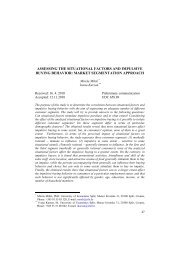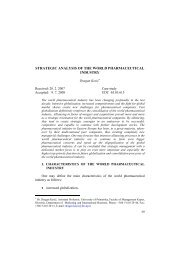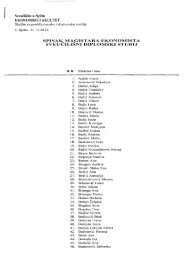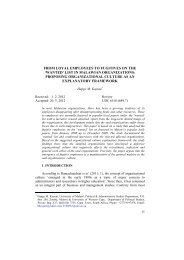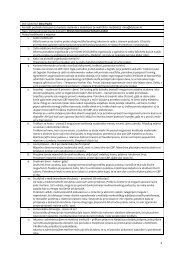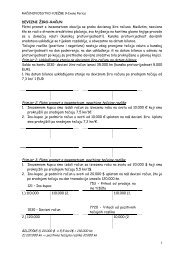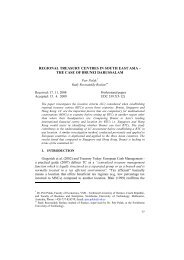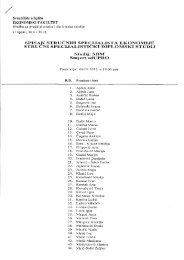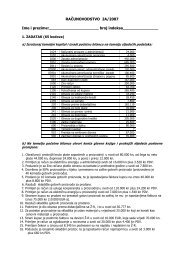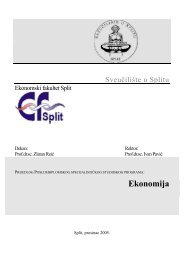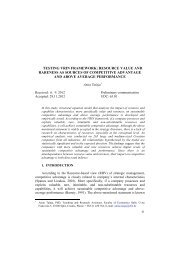the impact of the organisational structure and project organisational ...
the impact of the organisational structure and project organisational ...
the impact of the organisational structure and project organisational ...
Create successful ePaper yourself
Turn your PDF publications into a flip-book with our unique Google optimized e-Paper software.
Management, Vol. 16, 2011, 2, pp. 1-22<br />
A. Stare: The <strong>impact</strong> <strong>of</strong> <strong>the</strong> organizational <strong>structure</strong> <strong>and</strong> <strong>project</strong> organizational culture…<br />
Figure 3. Organisational <strong>structure</strong>s most <strong>of</strong>ten used by <strong>the</strong> enterprises<br />
Note: Figure represents <strong>the</strong> share (in %) <strong>of</strong> enterprises using a particular type <strong>of</strong><br />
<strong>the</strong> <strong>organisational</strong> <strong>structure</strong>.<br />
Correlation demonstrated that no particular type has a prominent <strong>impact</strong> on<br />
effective <strong>project</strong> execution. We also tried to join all three types <strong>of</strong> matrix<br />
organisation in one, <strong>and</strong> again <strong>the</strong>re was no correlation. We believe this is<br />
connected to <strong>the</strong> less well-defined position <strong>of</strong> <strong>project</strong> managers in different<br />
enterprises (<strong>and</strong> types <strong>of</strong> <strong>structure</strong>s). As we already knew that many enterprises<br />
had no “pr<strong>of</strong>essional” <strong>project</strong> managers (employed full-time as a manager), but<br />
instead experts managed <strong>project</strong>s in addition to <strong>the</strong>ir pr<strong>of</strong>essional work, it is<br />
underst<strong>and</strong>able that <strong>the</strong> results are not clear-cut.<br />
Only 15% <strong>of</strong> those managing <strong>the</strong> <strong>project</strong>s were employed full-time as<br />
<strong>project</strong> managers. A total <strong>of</strong> 19% <strong>of</strong> <strong>the</strong>m spend 90% <strong>of</strong> <strong>the</strong>ir time managing <strong>the</strong><br />
<strong>project</strong>, while 27% <strong>of</strong> “<strong>project</strong> managers” manage <strong>the</strong> <strong>project</strong> for less than 50%<br />
<strong>of</strong> <strong>the</strong>ir working time. However, considering <strong>the</strong> increasing level <strong>of</strong> authority<br />
(from little authority in a functional organisation to maximum authority in <strong>the</strong><br />
<strong>project</strong>-based organisation), an <strong>organisational</strong> <strong>structure</strong> where <strong>the</strong> <strong>project</strong><br />
manager has greater authority leads to reductions in <strong>project</strong> delays (Pearson<br />
Correlation C 0.176, Sig. 0.045) <strong>and</strong> costs (C 0.203, RSq 0.021).<br />
In addition, respondents’ answers showed <strong>the</strong> correlation <strong>of</strong> <strong>the</strong><br />
<strong>organisational</strong> <strong>structure</strong> <strong>and</strong> <strong>the</strong> level <strong>of</strong> respect <strong>of</strong> a <strong>project</strong> manager’s formal<br />
authority (C 0.290, Sig. 0.002), <strong>the</strong> following <strong>of</strong> <strong>project</strong> management<br />
regulations (C 0.254, Sig. 0.009), <strong>and</strong> <strong>the</strong> line manager’s attitude (C 0.237, Sig.<br />
0.012). All <strong>of</strong> <strong>the</strong>se correlations are shown in Figure 4.<br />
16



